Eccentric contractions do not induce rhabdomyolysis in malignant hyperthermia susceptible mice
- PMID: 18787086
- PMCID: PMC2584836
- DOI: 10.1152/japplphysiol.90926.2008
Eccentric contractions do not induce rhabdomyolysis in malignant hyperthermia susceptible mice
Abstract
Recent studies suggest a link between exercise-induced rhabdomyolysis and mutations of the ryanodine receptor (RYR1) associated with malignant hyperthermia (MH). We hypothesized that MH-susceptible mice (RYR1Y522S/wt) would exhibit greater anterior crural muscle [tibialis anterior (TA) and extensor digitorum longus (EDL) muscles] damage and strength deficits following the performance of a single or repeated bouts of eccentric contractions compared with wild-type (WT) mice. After a single injury bout, RYR1Y522S/wt mice produced more isometric torque than WT mice immediately and 3 and 7 days postinjury. Moreover, EDL muscle isometric specific force deficits were fully recovered for RYR1Y522S/wt but not WT mice 14 days postinjury. The percentage of fibers in TA muscle exhibiting signs of muscle damage 7 and 14 days postinjury were at least three times less in RYR1Y522S/wt than in WT mice. Uninjured and injured EDL muscle from RYR1Y522S/wt mice also displayed greater S-glutathionylation of RYR1 than that from WT mice. During the weekly injury bouts, torque production by RYR1Y522S/wt mice was fully recovered before the third and fourth injury bouts, whereas torque was still reduced for WT mice. Three days after multiple injury bouts, there were approximately 50% fewer fibers exhibiting signs of muscle damage in RYR1Y522S/wt than in WT TA muscle. These findings indicate that the RYR1Y522S/wt mutation protects skeletal muscle from exercise-induced muscle injury and do not support a direct association between MH susceptibility and contraction-induced rhabdomyolysis when core temperature is maintained at lower physiological temperatures during exercise.
Figures
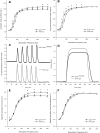
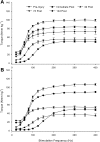
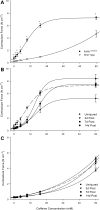
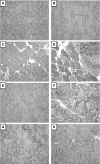
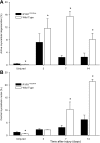

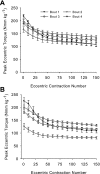

Similar articles
-
Oxidative capacity and fatigability in run-trained malignant hyperthermia-susceptible mice.Muscle Nerve. 2012 Apr;45(4):586-96. doi: 10.1002/mus.22343. Muscle Nerve. 2012. PMID: 22431093 Free PMC article.
-
FKBP12 deficiency reduces strength deficits after eccentric contraction-induced muscle injury.J Appl Physiol (1985). 2008 Aug;105(2):527-37. doi: 10.1152/japplphysiol.01145.2007. Epub 2008 May 29. J Appl Physiol (1985). 2008. PMID: 18511525 Free PMC article.
-
Strenuous exercise triggers a life-threatening response in mice susceptible to malignant hyperthermia.FASEB J. 2017 Aug;31(8):3649-3662. doi: 10.1096/fj.201601292R. Epub 2017 May 2. FASEB J. 2017. PMID: 28465322 Free PMC article.
-
Exercise-induced rhabdomyolysis and stress-induced malignant hyperthermia events, association with malignant hyperthermia susceptibility, and RYR1 gene sequence variations.ScientificWorldJournal. 2013;2013:531465. doi: 10.1155/2013/531465. Epub 2013 Feb 10. ScientificWorldJournal. 2013. PMID: 23476141 Free PMC article. Review.
-
RYR1-related rhabdomyolysis: A common but probably underdiagnosed manifestation of skeletal muscle ryanodine receptor dysfunction.Rev Neurol (Paris). 2016 Oct;172(10):546-558. doi: 10.1016/j.neurol.2016.07.018. Epub 2016 Sep 20. Rev Neurol (Paris). 2016. PMID: 27663056 Review.
Cited by
-
Implantation of in vitro tissue engineered muscle repair constructs and bladder acellular matrices partially restore in vivo skeletal muscle function in a rat model of volumetric muscle loss injury.Tissue Eng Part A. 2014 Feb;20(3-4):705-15. doi: 10.1089/ten.TEA.2012.0761. Epub 2013 Dec 19. Tissue Eng Part A. 2014. PMID: 24066899 Free PMC article.
-
Effect of prior exercise on thermal sensitivity of malignant hyperthermia-susceptible muscle.Muscle Nerve. 2010 Aug;42(2):270-2. doi: 10.1002/mus.21715. Muscle Nerve. 2010. PMID: 20544946 Free PMC article.
-
Contribution of minced muscle graft progenitor cells to muscle fiber formation after volumetric muscle loss injury in wild-type and immune deficient mice.Physiol Rep. 2017 Apr;5(7):e13249. doi: 10.14814/phy2.13249. Physiol Rep. 2017. PMID: 28400501 Free PMC article.
-
Preclinical model systems of ryanodine receptor 1-related myopathies and malignant hyperthermia: a comprehensive scoping review of works published 1990-2019.Orphanet J Rare Dis. 2020 May 7;15(1):113. doi: 10.1186/s13023-020-01384-x. Orphanet J Rare Dis. 2020. PMID: 32381029 Free PMC article.
-
Oxidative capacity and fatigability in run-trained malignant hyperthermia-susceptible mice.Muscle Nerve. 2012 Apr;45(4):586-96. doi: 10.1002/mus.22343. Muscle Nerve. 2012. PMID: 22431093 Free PMC article.
References
-
- Aracena P, Sanchez G, Donoso P, Hamilton SL, Hidalgo C. S-glutathionylation decreases Mg2+ inhibition and S-nitrosylation enhances Ca2+ activation of RyR1 channels. J Biol Chem 278: 42927–42935, 2003. - PubMed
-
- Aracena-Parks P, Goonasekera SA, Gilman CP, Dirksen RT, Hidalgo C, Hamilton SL. Identification of cysteines involved in S-nitrosylation, S-glutathionylation, and oxidation to disulfides in ryanodine receptor type 1. J Biol Chem 281: 40354–40368, 2006. - PubMed
-
- Avila G Intracellular Ca2+ dynamics in malignant hyperthermia and central core disease: established concepts, new cellular mechanisms involved. Cell Calcium 37: 121–127, 2005. - PubMed
-
- Baysal O, Taskapan H, Taskapan C, Kaya E, Sahin I, Kirimlioglu H, Karakas N. A case of rhabdomyolysis accompanying acute renal failure secondary to weight lifting. Clin Nephrol 60: 296–297, 2003. - PubMed
Publication types
MeSH terms
Substances
Grants and funding
LinkOut - more resources
Full Text Sources

